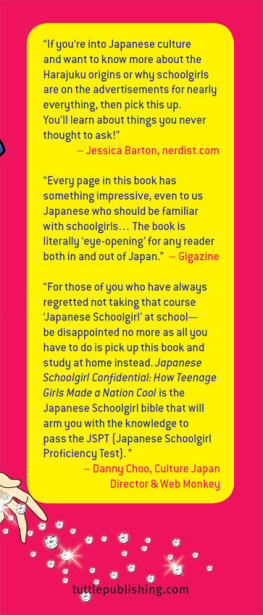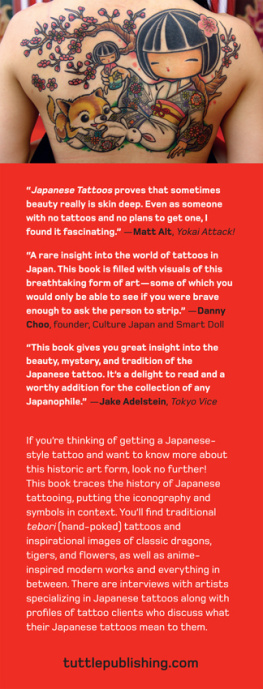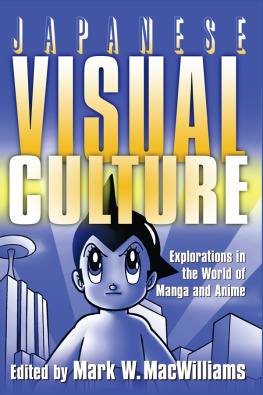Selected Bibliography
Anderson, Joseph L. and Donald Richie. The Japanese Film: Art and Industry . Princeton, NJ: Princeton University Press, 1982.
Bornoff, Nicholas. "Sex and Consumerism: The Japanese State of the Arts," in Consuming Bodies: Sex and Contemporary Japanese Art, ed. Fran Lloyd. London: Reaktion Books, 2002: 4168.
. Pink Samurai: The Pursuit and Politics of Sex in Japan. London: Grafton Books, 1991.
Clements, Jonathan, and Helen McCarthy. The Anime Encyclopedia: A Guide to Japanese Animation Since 1917. Berkeley, CA: Stone Bridge Press, 2006.
D, Chris. Outlaw Masters of Japanese Film. London: I.B. Tauris, 2005.
Galbraith, Patrick W. The Otaku Encyclopedia: An Insiders Guide to the Subculture of Cool Japan. Tokyo: Kodansha International, 2009.
Gravett, Paul. Manga: Sixty Years of Japanese Comics. New York: Collins Design, 2004.
Hasegawa, Yuko. Post-identity Kawaii : Commerce, Gender and Contemporary Japanese Art, in Consuming Bodies: Sex and Contemporary Japanese Art, ed. Fran Lloyd. London: Reaktion Books, 2002: 127141.
Inamasu, Tatsuo. Aidoru Kougaku (Idol Engineering). Tokyo: Chikuma Shobo, 1989.
Kinsella, Sharon. Cuties in Japan, in Women Media and Consumption in Japan, eds. Lise Skov and Brian Moeran. Honolulu, HI: University of Hawaii Press, 1995: 220254.
. Whats Behind the Fetishism of Japanese School Uniforms? in Fashion Theory, Volume 6, Issue 2, 2002: 215238.
Kizaki, Yoshiji and Kasumi Akaiwa. Rock & Pops Standard 1955-64 Vol 1 . Tokyo: Ongaku Shuppansha, 2005.
Lloyd, Fran. Strategic Interventions in Contemporary Japanese Art, in Consuming Bodies: Sex and Contemporary Japanese Art, ed. Fran Lloyd. London: Reaktion Books, 2002: 69108.
Macias, Patrick, and Izumi Evers. Japanese Schoolgirl Inferno: Tokyo Teen Fashion Subculture Handbook. San Francisco: Chronicle Books, 2007.
Maeda, Masahiro. Norifumi Suzuki Special HOTWAX Vol. 8. Tokyo: Shinko Music Entertainment Co., Ltd., 2007.
Miller, Laura. Those Naughty Teenage Girls: Japanese Kogals, Slang, and Media Assessments, in Journal of Linguistic Anthropology , Volume 14, Number 2, 2004: 225242.
Miller, Laura, and Jan Bardsley, eds. Bad Girls of Japan. New York: Palgrave Macmillan, 2005.
Napier, Susan. Vampires, Psychic Girls, Flying Women and Sailor Scouts: Four Faces of the Young Female in Japanese Popular Culture, in The Worlds of Japanese Popular Culture, ed. D.P. Martinez. Cambridge, UK: Cambridge University Press, 1998: 91106.
Orbaugh, Sharalyn. Busty Battlin Babes: The Evolution of the Shojo in 1990s Visual Culture, in Gender and Power: In the Japanese Visual Field, eds. Joshua S. Mostow, Norman Bryson, and Maribeth Graybill. Honolulu, HI: University of Hawaii Press, 2003.
Pilling, David. Marketing: Small, But Perfectly Funded, in The Financial Times . October 11, 2005.
Richie, Donald. A Hundred Years of Japanese Film: A Concise History, with a Selective Guide to DVDs and Videos. Tokyo: Kodansha International, 2005.
Sato, Barbara. The New Japanese Woman: Modernity, Media, and Women in Interwar Japan. Durham: Duke University Press, 2003.
Satsukime, Masako, ed. Queen of Japanese Movie: From Stray Cat Rock to Girl Boss Blues . HOTWAX special edition . Tokyo: Shinko Music Entertainment Co., Ltd., 2006.
Schilling, Mark. No Borders, No Limits: Nikkatsu Action Cinema. Guildford, UK: FAB Press, 2007. Honolulu, HI: University of Hawaii Press, 2003: 201227.
Sharp, Jasper. Behind the Pink Curtain: The complete History of Japanese Sex Cinema. Guildford, UK: FAB Press, 2008.
Shibuya Trend Research Group/ING, Jidai o Tsukuru Girls Culture: Sedai goto ni miru Jyoshi koukousei no Lifestyle , Tokyo: Goma Books, 2006.
Sugisaku, J Taro. Pinky Violence Tokuma Shoten. Tokyo: Tokuma Shoten, 1999.
White, Merry. The Marketing of Adolescence in Japan: Buying and Dreaming, in Women Media and Consumption in Japan, eds. Lise Skov and Brian Moeran. Honolulu, HI: University of Hawaii Press, 1995: 255273.
Websites
2channel
http://www.2ch.net
Akiba Blog
http://akibablog.net
Canned Dogs
http://zepy.momotato.com
Danny Choo
http://www.dannychoo.com
Encyclopedia Idollica
http://www.idollica.com
Gigazine
http://gigazine.net/
Kotaku
http://kotaku.com
Japan Probe
http://www.japanprobe.com
Matt Thorn
http://www.matt-thorn.com
MidnightEye
http://www.midnighteye.com
Patrick Macias
http://patrickmacias.blogs.com
Speed Nator
http://www.ne-ta.com
Magazines
an-an
Bessatsu Friend
Brutus
Cawaii!
CUTiE
Cyzo
Dengeki Hime
Dengeki Gs Magazine
egg
Famitsu
Hana*chu
Nakayoshi
Newtype (Japan)
nicola
Otaku USA
Popteen
Ribon
Ranzuki
S Cawaii!
Shojo Friend
Seventeen
Weekly Playboy
Wired

If clothes make the man, uniforms make the schoolgirl. Whether its those sailor suits with big red ribbons, blue blazers with striped neckties, or short plaid skirts and loose socks, the Japanese schoolgirl uniform is more than a wearable ID. Its a statement. With roughly 95 percent of high schools in Japan requiring them, wearing uniforms ( seifuku ) is not simply the norm, but a rite of passage, representing that carefree period in a womans life when she makes the transition from child to adult.

It wasnt always this way. At the Tombow Uniform Museum in Okayama, costumed mannequins are displayed in a timeline revealing the evolution of uniforms. The museum is Japans only academic garb repository and sits catty-corner to Tombows school uniform factory, where threads are fabricated for students across the country. Okayama is the uniform capital of Japan, and if youre wearing a Japanese school uniform right now, theres a seven out of ten chance its from there.
The groundwork for mandated clothing in Japan was laid in the seventh and eighth centuries, when Korean- and Chinese-influenced imperial decrees compelled the classes to wear certain types of clothes. During the Heian Period (7941185 ad), idle aristocrats were obsessed with seemingly trivial wardrobe matters like wearing the correct colored sleeves. When your days arent spent toiling in a rice paddy, even the most minor fashion detail is important!
By the Edo Period (16001868), regular kids could study calligraphy, poetry, and Buddhism at their local temples. In a glass case at the Tombow museum, two smiling life-sized dolls are dressed in their regal study kimonos: one sits on the floor, and the other stands, grinning ear-to-ear. These study clothes were threads donned for learning, but not strictly enforced or even uniform per se. For something to truly be a uniform it needs to be exactly the same, and that wouldnt happen to Japanese school clothes until the late nineteenth century.
Hello sailor!
FOLLOWING THE OPENING OF JAPAN in 1853 by the Black Ships of the US Navy, large numbers of foreign experts in a myriad of fields and industries were brought in to dispense their knowledge. Western fashion also began to be adopted, and leading the charge was the Meiji Emperor who posed for photographs in French-inspired military garb, complete with a sash, fringed epaulettes, and a breast full of medals.














